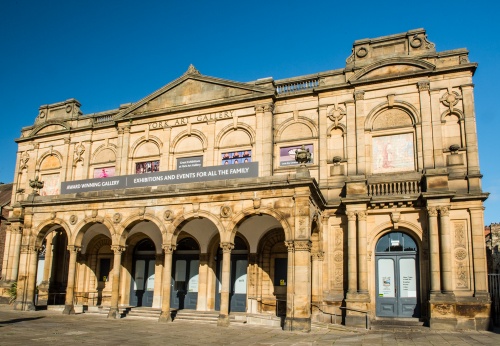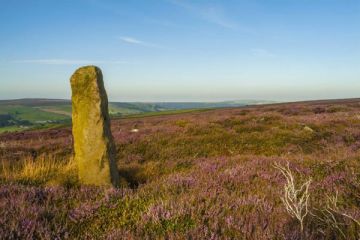
The York Art Gallery (formerly the City Art Gallery) is a public art gallery across from York's historic Bootham Bar. The Gallery is home to the finest collection of artwork in York, with works spanning 600 years, including paintings, sculpture, and ceramics. It holds the largest collection anywhere of works by York artist William Etty, and a statue of Etty stands in the square in front of the museum entrance.
History
In 1866 York was the setting for the 'Yorkshire Fine Art and Industrial Exhibition', inspired by the Great Exhibition of 1851 in London. Thirteen years later in 1879, a second Exhibition was planned. As part of the second Exhibition, a large public gallery was erected to a design by Edward Taylor a stone's throw west of Bootham Bar, one of the historic medieval gateways into the walled city.
The 1879 Exhibition was a huge success, attracting over 500,000 visitors and making a profit of some £12,000. The Gallery was kept intact after the Exhibition closed, and from 1880 it was known as the Yorkshire Fine Art and Industrial Institution.

In 1882 a retired horse dealer named John Burton bequeathed his art collection the city. Burton had served on the organising committees of both the 1866 and the 1879 Exhibitions. He had intended to leave his paintings to the National Gallery in London but was persuaded to alter his will and leave them to the new gallery here in York.
In 1934 WA Evelyn left a huge collection of historic photographs of York to the Gallery. After WWII the Dean of York Minster, Eric Milner-White presented the Gallery with 35 British paintings, while another local benefactor named Lycett Green gave the Gallery his collection of Old Master Paintings.
The original Gallery was about twice the size of the building we see today, with a huge Great Exhibition Hall stretching out to the rear. This Hall was six times as large as the present Main Gallery and served as a multipurpose event venue, hosting things as diverse as cock fighting and boxing matches. The Hall was struck by bombs in WWII and pulled down in 1942.
The Gallery overlooks Exhibition Square, built as the centrepiece of the 1879 Exhibition. The Gallery was renamed the City Art Gallery in 1892 but is now known as the York Art Gallery.

Highlights
There are several themed areas within the Gallery including Decorative Arts, Paintings, Studio Pottery, and Works on Paper.
The Decorative Arts collection holds over 3,000 objects including Yorkshire ceramics dating to the 17th century. Famous ceramic makers represented include Delft and Rockingham. See Chinese, Korean, and English pottery pieces including Toby jugs, teapots, and dinner services.
The Painting Collection has over 1,000 works of art from the 14th century to the Victorian period. See a series of golden panels from Italy made to serve as church altarpieces. There are large collections of Dutch and French art, as well as British paintings from the Tudor period to the present day. The collection includes works by local artist William Etty and the early 20th-century collective known as the Camden Town Group.

The Studio Pottery Collection boasts 5,000 pieces made by such well-known potters as Michael Cardew, Bernard Leach, William Staite Murray, Mick Casson, Lucie Rie, Jim Malone, Shoji Hamada, and Hans Coper.
The works on Paper Collection has over 17,000 watercolours, prints, and drawings. Roughly half of these works are landscapes and some 4,000 show scenes of York. In addition, the collection has works by such famous artists as JMW Turner, Thomas Girtin, and Thomas Rowlandson. There is a large collection of archival material by William Etty, such as sketches and personal letters.
One striking object is an Automaton Clock built in the 1780s. The case dates to the middle of the 18th century and the clockwork mechanism to the 1770s. The is a marvel, with 26 moving figures on the front with more figures behind crossing a bridge. A figure of Hercules strikes the hours.

Getting There
The York Art Gallery is on Exhibition Square, a five-minute walk from York Minster and almost directly opposite Bootham Bar, just outside the old city walls. The nearest car park is on Marygate, just off the A19. There are bus stops on Exhibition Square.
There is a charge for admission.
About York Art Gallery
Address: Exhibition Square,
York,
Yorkshire,
England, YO1 7EW
Attraction Type: Museum - Art Gallery
Location: On Exhibition Square opposite Bootham Bar. The nearest car park is on Marygate.
Website: York Art Gallery
Location
map
OS: SE600522
Photo Credit: David Ross and Britain Express
HERITAGE
 We've 'tagged' this attraction information to help you find related historic attractions and learn more about major time periods mentioned.
We've 'tagged' this attraction information to help you find related historic attractions and learn more about major time periods mentioned.
Find other attractions tagged with:
NEARBY HISTORIC ATTRACTIONS
Heritage Rated from 1- 5 (low to exceptional) on historic interest
King's Manor - 0 miles (Historic Building) ![]()
Anglian Tower - 0.1 miles (Historic Building) ![]()
Yorkshire Museum - 0.1 miles (Museum) ![]()
St Wilfrid's Catholic Church - 0.1 miles (Historic Church) ![]()
Multangular Tower - 0.1 miles (Roman Site) ![]()
York Minster - 0.1 miles (Cathedral) ![]()
York, St Olave's Church - 0.1 miles (Historic Church) ![]()
St Leonard's Hospital - 0.1 miles (Historic Building) ![]()












